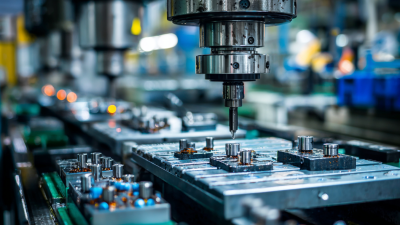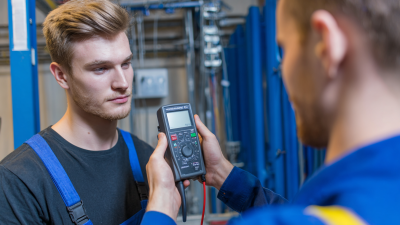Navigating the Challenges of Precision Devices in Today's High Demand Markets
In today's rapidly evolving market landscape, the demand for precision devices has reached unprecedented heights, driven by advancements in technology and the increasing complexity of applications across various industries. According to a recent report by MarketsandMarkets, the global precision device market is projected to grow from $20 billion in 2022 to over $35 billion by 2027, representing a compound annual growth rate (CAGR) of 10.5%. This surge underscores the critical role that precision devices play in sectors such as healthcare, aerospace, and manufacturing, where accuracy and reliability are paramount. However, companies face significant challenges in navigating this competitive environment, including supply chain disruptions, technological innovations, and stringent regulatory requirements. As organizations strive to meet the high expectations of modern consumers and navigate the intricacies of precision devices, understanding these challenges becomes essential for sustaining growth and ensuring long-term success.

Understanding the Increasing Demand for Precision Devices in Various Industries
In today's rapidly evolving markets, the demand for precision devices across various industries is witnessing significant growth. According to forecasts, the global GPS market is set to expand from $119.47 billion in 2024 to $402.43 billion by 2032, marking a remarkable compound annual growth rate (CAGR) of 16.4%. This surge highlights the necessity for precision in navigation and location services, integral for sectors ranging from transportation to healthcare.
The precision medicine market is also experiencing substantial developments, projected to increase as diverse technologies such as diagnostics, devices, and software become more prevalent. For instance, precision diagnostics, including genetic and biomarker testing, reflect the market's shift towards personalized approaches in healthcare, addressing specific patient needs more effectively than ever before.
Tip: For companies looking to leverage these trends, investing in advanced manufacturing techniques like CNC (Computer Numerical Control) can significantly enhance production efficiency and precision. Additionally, focusing on eco-friendly operations could not only reduce costs but also appeal to a market increasingly concerned about sustainability. Understanding the dynamics of these growing sectors is essential for stakeholders aiming to capitalize on the opportunities presented by high-demand precision devices.
Key Challenges Facing Precision Device Manufacturers Today
In today's high-demand markets, precision device manufacturers are facing a multitude of challenges that require strategic navigation. With increasing global competition and evolving technology, companies must respond effectively to maintain their market position. The recent shift in the industry, highlighted by significant acquisitions focused on precision metal components, underscores the growing importance of these core components embedded in smart devices. This strategic pivot not only addresses immediate production needs but also enhances competitive capabilities in precision manufacturing.
Furthermore, as advancements in smart manufacturing and Industry 4.0 gain traction, manufacturers are confronted with the necessity for improved quality control and efficiency. Companies must balance the demands of innovative production techniques against the challenges posed by geopolitical instability and economic pressures. The successes of leading firms amid these challenges demonstrate the importance of adaptability and strategic investment in precision devices to meet consumer demands while ensuring operational stability. As the landscape continues to evolve, manufacturers must prioritize precision and quality to thrive in this increasingly complex environment.
Navigating the Challenges of Precision Devices in Today's High Demand Markets
This chart illustrates the key challenges faced by precision device manufacturers in the current high-demand markets. The data reflects common issues such as supply chain disruptions, increasing production costs, quality control challenges, and technology adaptation.
The Impact of Technology Advancements on Precision Device Production
In recent years, advancements in technology have significantly transformed the production landscape of precision devices. According to the latest Industry Research report, the global precision devices market is expected to grow from $300 billion in 2022 to approximately $450 billion by 2028, which underscores the rising demand for innovative solutions. These advancements, such as automation, artificial intelligence, and advanced materials, enable manufacturers to enhance productivity and precision while reducing costs.
To thrive in this competitive environment, companies should focus on leveraging these technological advancements. **Tip 1:** Invest in automation tools that improve efficiency and reduce human error in production processes. This will not only enhance product quality but also accelerate manufacturing timelines. **Tip 2:** Collaborate with tech startups and research institutions to stay ahead of the curve and adopt cutting-edge technologies early in the development phase.
Furthermore, as sustainability becomes paramount, manufacturers must integrate eco-friendly practices into their production lines. According to a recent sustainability report, 74% of consumers prefer products made with sustainable materials. **Tip 3:** Adopting sustainable practices and materials can not only improve marketability but also align with the growing consumer demand for environmentally responsible products. By embracing these advancements, manufacturers will be better positioned to navigate the complexities of high-demand markets.
Navigating the Challenges of Precision Devices in Today's High Demand Markets
| Dimension | Metric | 2021 | 2022 | 2023 |
|---|---|---|---|---|
| Market Demand (Units) | Growth Rate (%) | 5% | 7% | 10% |
| Production Efficiency (%) | Increase Rate (%) | 75% | 78% | 82% |
| Technology Investment (Million $) | Annual Growth (%) | 100 | 120 | 150 |
| Defect Rate (%) | Reduction Rate (%) | 3.5% | 3.0% | 2.5% |
| Customer Satisfaction Score | Score (Out of 10) | 8.0 | 8.5 | 9.0 |
Strategies for Overcoming Supply Chain Disruptions in High Demand Markets
In today’s fast-paced markets, precision device manufacturers face significant supply chain disruptions that threaten both product availability and operational efficiency. Companies must adopt proactive strategies to mitigate these challenges and ensure they can meet increasing consumer demands. One effective approach involves building diversified supplier networks. By collaborating with multiple suppliers across different regions, businesses can reduce dependency on a single source and increase resilience against geopolitical events or natural disasters.
Another key strategy is to invest in robust inventory management systems that provide real-time visibility into stock levels and supplier performance. This allows companies to anticipate potential shortages and take corrective actions swiftly. Implementing demand forecasting tools can further enhance this process, enabling manufacturers to better align their production schedules with market trends.
**Tips:**
- Establish strategic partnerships with suppliers that share your values and commitment to quality.
- Regularly review and revise supply chain contracts to include clauses that address potential disruptions.
- Leverage technology such as blockchain to enhance transparency and traceability across the supply chain, ensuring better decision-making during disruptions.
Future Trends Shaping the Precision Device Market and Their Implications
The precision device market is experiencing transformative growth, driven by rapid advancements in technology and increasing demand across various sectors. According to industry forecasts, the electroplating equipment market is set to expand from $80.285 million to approximately $131.546 million by 2030, reflecting a robust compound annual growth rate (CAGR) of 6.37%. Such growth underscores the escalating need for precision in manufacturing processes, which is vital for maintaining quality and efficiency in high-demand markets.

In the realm of microscopy, the market is projected to rise from $9.1 billion in 2023 to $17.4 billion by 2032. This surge is largely attributed to the intensified focus on nanotechnology and regenerative medicine, which necessitate advanced precision devices for research and development. Furthermore, the microbattery market is also poised for significant expansion, with estimates suggesting growth from $519.78 million in 2024 to over $2.16355 billion by 2032, highlighting the increasing application of precision devices in portable technologies and energy solutions. These trends reflect a broader movement towards precision in various industries, signifying a shift that will profoundly shape the market landscape in the coming years.
Related Posts
-

5 Reasons Why Precision Devices Are Essential for Modern Manufacturing Success
-

The Future of Test Instruments in Industry Innovation
-

5 Essential Tips for Choosing the Right Liquid Filled Gauges
-

Top Strategies for Utilizing Digital Gauges in HVAC Efficiency
-

Advantages of Using Marsh Gauges for Accurate Measurement in Various Industries
-

The Ultimate Guide to Choosing the Perfect Digital Manometer for Your Needs
Contact
3295 Cobb International Blvd.
Kennesaw, GA 30152
800-367-1377
sale@patiostools.com
Info
© 2023 - Marsh Instruments


